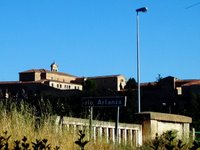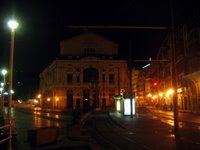Every trip has a departure point, which in this case is Cancun, in the Mexican state of Quintana Roo. A reknown touristic destination and the possible reason why you can find cheap flights between America and Europe. Now, when I arrived to the airport I was informed that my flight was slightly delayed. Minutes went by and then hours, yes, it was delayed almost three hours, nice way to start a one month trip.
I finally got on the plane and when I saw the table with newspapers I must have had a startled look on my face because the flight attendant offered me a couple of options: El Páis or ABC. I kindly refused explaining to her that I would actually prefer to read the news. She gave me a look that told me that she agreed with me and that was it for the newspapers. Besides, I had a book with me which I chose for the long hours on board of the plane,
Cartas a Elizabeth by Antonio Velasco Piña.
Since it was past 10:00pm when we took off I waited for dinner to be served and then, since I was all by myself (there was no one seating next to me) I simply proceeded to get as comfortable as I could to be able to endure the flight to Madrid.

It was around 7:00 am my time when we arrived to the Barajas airport, then I had to wait in line for little over an hour to go through immigration. I finally got to the bus stop outside the airport since I needed to go to the bus station at a place everyone called "Las Américas". I finally got there and I was lucky enough

to find a ticket for a bus that would depart for Bilbo (Bilbao) in just twenty minutes.
I tried to enjoy the view during the road trip from Madrid to Bilbo, but it is so arid and boring that I fell asleep until we got to
Lerma, a city right next to a river by the name Arlanza.

I liked what I could see of the town from the bus stop and I snapped a couple of pictures. I grabbed a bite and a coke and then we continued on our way. I fell asleep again but somehow I managed to open my eyes right when a big sign on the side of the road said "Ongi Etorri".
Finally, I was in Euskal Herria, the Basque Country.
And here I am.
~ ~ ~
 Police officers in full riot gear watch over hundreds of Basque separatists marching in support of senior ETA member Inaki de Juana Chaos in San Sebastian August 26, 2006. The banner reads in Basque, 'No to life sentence. Release Inaki de Juana.' REUTERS/Pablo Sanchez (SPAIN)
Police officers in full riot gear watch over hundreds of Basque separatists marching in support of senior ETA member Inaki de Juana Chaos in San Sebastian August 26, 2006. The banner reads in Basque, 'No to life sentence. Release Inaki de Juana.' REUTERS/Pablo Sanchez (SPAIN)











